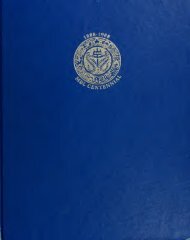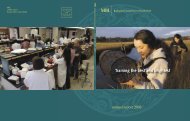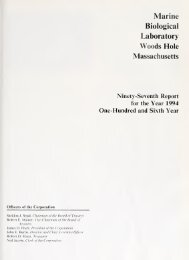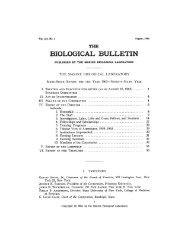General embryological information service - HPS Repository
General embryological information service - HPS Repository
General embryological information service - HPS Repository
Create successful ePaper yourself
Turn your PDF publications into a flip-book with our unique Google optimized e-Paper software.
64 pictures are phase contrast photographs of living ova. The later stages<br />
were incubated in follicular fluid, or in serum to which pieces of tubal mucosa<br />
had been added. The atlas is divided into 5 sections, dealing respectively with<br />
growth, maturation, nutrition, fertilization and early development.lt is preceded<br />
by a short historical introduction by H. Speert, and concluded by an appendix<br />
containing some <strong>information</strong> on the techniques used, a bibliography of earlier<br />
publications of the author, and a curriculum vitae. Concise texts in German,<br />
French and English accompany the plates, forming a more or less continuous<br />
story. The reproduction and printing of the plates are very good.<br />
It is a pity that the technique used for making each picture could not have been separately<br />
indicated. Also one would have wished for more technical detail about the phase contrast<br />
procedure used, particularly as regards illumination.<br />
"THE BIOLOGY OF STENTOR"<br />
1961<br />
by V. Tartar Pergamon Press<br />
(International Series of Oxford, London, New York, Paris<br />
Monographs on Pure and Applied Price: 75 s.<br />
Biology, Zoology Division, Vol. 5)<br />
413 pp., 99 figs., 1 coloured pi.<br />
This monograph is devoted entirely to one genus, the ciliate protozoan<br />
Stentor. So much <strong>information</strong> about this genus has accumulated in the course<br />
of more than a hundred years, that a compilation into one volume is fully<br />
justified. In the bibliography of this book there are more than 200 titles dealing<br />
with the genus Stentor alone.<br />
The author of the book has been engaged in experimental work on these<br />
organisms for a period of twenty years. Stentor is better suited for microsurgical<br />
manipulations than any other unicellular organism, and with this book<br />
the author hopes to provide the basis for much more experimental work.<br />
Much of the experimental work compiled in this book deals with morphogenesis<br />
in its widest sense, and is therefore of direct interest to embryologists.<br />
The book includes a useful chapter on experimental techniques. A final<br />
chapter presents some theoretical considerations concerning, among other<br />
things, the interactions between nucleus, endoplasm and ectoplasm, and more<br />
particularly the autonomous pattern present in the latter.<br />
The book is richly illustrated with simple but clear line drawings. The<br />
bibliography is divided into a part dealing with Stentor, and a general part.<br />
There are author and subject indexes. The printing of the book is very good.<br />
"NEW APPROACHES IN CELL BIOLOGY"<br />
1960<br />
Editor: P. M. B. Walker Academic Press<br />
216 pp., 58 figs., 3 tabs. London and New York<br />
This book contains the papers delivered at a symposium which formed part<br />
of the fifteenth International Congress of Zoology, held in London in 1958.<br />
At least six of the fourteen papers are of direct interest to embryologists.<br />
Among these are papers by Moore (nuclear transfer of embryonic cells),<br />
Waddington (ultramicroscopic structure of developing systems), and Clayton<br />
(labelled antibodies and differentiation).<br />
The papers generally range from about ten to about twenty pages. Some of<br />
284
















